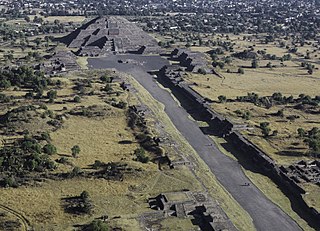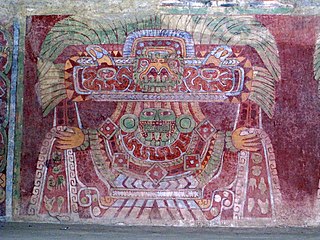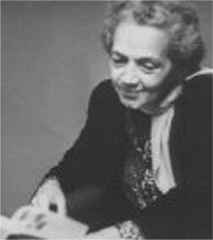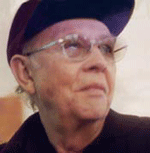Related Research Articles

Tlaloc is a member of the pantheon of gods in Aztec religion. As supreme god of the rain, Tlaloc is also a god of earthly fertility and of water. He was widely worshipped as a beneficent giver of life and sustenance. However, he was also feared for his ability to send hail, thunder, and lightning, and for being the lord of the powerful element of water. Tlaloc is also associated with caves, springs, and mountains, most specifically the sacred mountain in which he was believed to reside. His animal forms include herons and water-dwelling creatures such as amphibians, snails, and possibly sea creatures, particularly shellfish. The Mexican marigold, Tagetes lucida, known to the Aztecs as yauhtli, was another important symbol of the god, and was burned as a ritual incense in native religious ceremonies.

The Toltec culture (/ˈtɒltɛk/) was a pre-Columbian Mesoamerican culture that ruled a state centered in Tula, Hidalgo, Mexico during the Epiclassic and the early Post-Classic period of Mesoamerican chronology, reaching prominence from 950 to 1150 CE. The later Aztec culture saw the Toltecs as their intellectual and cultural predecessors and described Toltec culture emanating from Tōllān[ˈtoːlːaːn] as the epitome of civilization; in the Nahuatl language the word Tōltēcatl[toːlˈteːkat͡ɬ] (singular) or Tōltēcah[toːlˈteːkaʔ] (plural) came to take on the meaning "artisan". The Aztec oral and pictographic tradition also described the history of a Toltec Empire, giving lists of rulers and their exploits.

Teotihuacan is an ancient Mesoamerican city located in a sub-valley of the Valley of Mexico, which is located in the State of Mexico, 40 kilometers (25 mi) northeast of modern-day Mexico City. Teotihuacan is known today as the site of many of the most architecturally significant Mesoamerican pyramids built in the pre-Columbian Americas. At its zenith, perhaps in the first half of the first millennium, Teotihuacan was the largest city in the pre-Columbian Americas, with a population estimated at 125,000 or more, making it at least the sixth-largest city in the world during its epoch.

In the history of the Americas, the pre-Columbian era spans from the original settlement of North and South America in the Upper Paleolithic period through European colonization, which began with Christopher Columbus's voyage of 1492. Usually the era covers the history of indigenous American cultures until significant influence by Europeans. This may have occurred decades or even centuries after Columbus for certain cultures.

Chalchiuhtlicue[t͡ʃaːɬt͡ʃiwˈt͡ɬikʷeː] is an Aztec deity of water, rivers, seas, streams, storms, and baptism. Chalchiuhtlicue is associated with fertility, and she is the patroness of childbirth. Chalchiuhtlicue was highly revered in Aztec culture at the time of the Spanish conquest, and she was an important deity figure in the Postclassic Aztec realm of central Mexico. Chalchiuhtlicue belongs to a larger group of Aztec rain gods, and she is closely related to another Aztec water god called Chalchiuhtlatonal.

The Great Goddess of Teotihuacan is a proposed goddess of the pre-Columbian Teotihuacan civilization, in what is now Mexico.

Laurette Séjourné was a Mexican archeologist and ethnologist best known for her study of the civilizations of Teotihuacan and the Aztecs and her theories concerning the Mesoamerican culture hero, Quetzalcoatl.

Mesoamerican pyramids form a prominent part of ancient Mesoamerican architecture. Although similar in some ways to Egyptian pyramids, these New World structures have flat tops and stairs ascending their faces. The largest pyramid in the world by volume is the Great Pyramid of Cholula, in the east-central Mexican state of Puebla. The builders of certain classic Mesoamerican pyramids have decorated them copiously with stories about the Hero Twins, the feathered serpent Quetzalcoatl, Mesoamerican creation myths, ritualistic sacrifice, etc. written in the form of hieroglyphs on the rises of the steps of the pyramids, on the walls, and on the sculptures contained within.
Doris Heyden was a prominent scholar of pre-Columbian Mesoamerican cultures, particularly those of central Mexico. She was born in East Orange, New Jersey, United States. She died on September 25, 2005 from the lingering after effects of a stroke suffered in 1999.
Mesoamerica, along with Mesopotamia and China, is one of three known places in the world where writing is thought to have developed independently. Mesoamerican scripts deciphered to date are a combination of logographic and syllabic systems. They are often called hieroglyphs due to the iconic shapes of many of the glyphs, a pattern superficially similar to Egyptian hieroglyphs. Fifteen distinct writing systems have been identified in pre-Columbian Mesoamerica, many from a single inscription. The limits of archaeological dating methods make it difficult to establish which was the earliest and hence the forebear from which the others developed. The best documented and deciphered Mesoamerican writing system, and the most widely known, is the classic Maya script. Earlier scripts with poorer and varying levels of decipherment include the Olmec hieroglyphs, the Zapotec script, and the Isthmian script, all of which date back to the 1st millennium BC. An extensive Mesoamerican literature has been conserved, partly in indigenous scripts and partly in postconquest transcriptions in the Latin script.

Mesoamerican architecture is the set of architectural traditions produced by pre-Columbian cultures and civilizations of Mesoamerica, traditions which are best known in the form of public, ceremonial and urban monumental buildings and structures. The distinctive features of Mesoamerican architecture encompass a number of different regional and historical styles, which however are significantly interrelated. These styles developed throughout the different phases of Mesoamerican history as a result of the intensive cultural exchange between the different cultures of the Mesoamerican culture area through thousands of years. Mesoamerican architecture is mostly noted for its pyramids, which are the largest such structures outside of Ancient Egypt.
George Alexander Kubler was an American art historian and among the foremost scholars on the art of Pre-Columbian America and Ibero-American Art.

The Feathered Serpent was a prominent supernatural entity or deity, found in many Mesoamerican religions. It is still called Quetzalcoatl among the Aztecs, Kukulkan among the Yucatec Maya, and Q'uq'umatz and Tohil among the K'iche' Maya.

Robert E. Lee Chadwick was an American anthropologist and archeologist, primarily known for his contributions to the Handbook of Middle American Indians.
Janet Catherine Berlo is an American art historian and academic, noted for her publications and research into the visual arts heritage of Native American and pre-Columbian cultures. She has also published and lectured on gender studies, the representation and participation of women in indigenous and visual arts, the history of graphic arts since the mid-19th century, indigenous textile arts, and American quilting history and traditions. In the early portion of her academic career Berlo made notable contributions towards the understanding of the art and iconography of Mesoamerica, in particular that of the Classic-period Teotihuacan civilization. Since 2003 Berlo has held the position of Professor of Art History and Visual and Cultural Studies at the Department of Art and Art History, University of Rochester, New York.

In Mesoamerican culture, Tonatiuh was an Aztec sun deity of the daytime sky and ruled the cardinal direction of east. According to Aztec Mythology, Tonatiuh was known as "The Fifth Sun" and was given a calendar name of naui olin, which means "4 Movement". Represented as a fierce and warlike god, he is first seen in Early Postclassic art of the Pre-Columbian civilization known as the Toltec. Tonatiuh's symbolic association with the eagle alludes to the Aztec belief of his journey as the present sun, travelling across the sky each day, where he descended in the west and ascended in the east. It was thought that his journey was sustained by the daily sacrifice of humans. His Nahuatl name can also be translated to "He Who Goes Forth Shining" or "He Who Makes The Day." Tonatiuh was thought to be the central deity on the Aztec calendar stone but is no longer identified as such. In Toltec culture, Tonatiuh is often associated with Quetzalcoatl in his manifestation as the morning star aspect of the planet Venus.

Painting in the Americas before European colonization is the Precolumbian painting traditions of the Americas. Painting was a relatively widespread, popular and diverse means of communication and expression for both religious and utilitarian purpose throughout the regions of the Western Hemisphere. During the period before and after European exploration and settlement of the Americas; including North America, Central America, South America and the islands of the Caribbean, the Bahamas, the West Indies, the Antilles, the Lesser Antilles and other island groups, indigenous native cultures produced a wide variety of visual arts, including painting on textiles, hides, rock and cave surfaces, bodies especially faces, ceramics, architectural features including interior murals, wood panels, and other available surfaces. Many of the perishable surfaces, such as woven textiles, typically have not been preserved, but Precolumbian painting on ceramics, walls, and rocks have survived more frequently.
Arthur G. Miller is an American art historian, archaeologist and academic. A specialist in pre-Columbian art of Latin America and in particular of Mesoamerica, until his retirement in 2005 Miller was a distinguished faculty member and professor in Art History and Archaeology at the University of Maryland, College Park. Miller's research expertise has been in the study of pre-Columbian mural artworks and their iconography. He has published numerous academic papers and books on the mural art of Mesoamerican cultures, such as Classic-era Teotihuacan of central Mexico, Zapotec tombs and sites in Oaxaca, and Maya sites along the eastern coastline of the Yucatán Peninsula.
Helen Perlstein Pollard is an American academic ethnohistorian and archaeologist, known for her publications and research on pre-Columbian cultures in the west-central Mexico region.
Mesoamerican cosmovision or cosmology is the collection of worldviews shared by the Indigenous pre-Columbian societies of Mesoamerica. The cosmovision of these societies was reflected in the ways in which they were organized, such as in their built environment and social hierarchies, as well as in their epistemologies and ontologies, including an understanding of their place within the cosmos or universe. Elements of Mesoamerican cosmovision are reflected in pre-Columbian textual sources, such as the Popol Vuh and the Cuauhtinchan maps, the archeological record, as well as in the contemporary beliefs, values, and practices of Indigenous people, such as the Maya, Nahua, and Purépecha, as well as their descendants. It has been argued that the Day of the Dead ceremony exists as a legacy of Mesoamerican cosmovision.
References
- ↑ "Esther Pasztory". Department of Art History & Archaeology, Columbia University.
{{cite web}}: CS1 maint: url-status (link) - 1 2 3 https://arthistory.columbia.edu/sites/default/files/content/faculty/pdfs/pasztory/Pasztory-CV.pdf [ bare URL PDF ]
- ↑ "Esther Pasztory Festschrift - Department of Art History and Archaeology - Columbia University". Archived from the original on 30 April 2021.
- ↑ Prior texts addressing the arts of these cultures assumed either an archeological or anthropological stance, as in the works of Rene Millon and other pioneers of Pre-Columbian studies.
- ↑ Townsend, Richard F. (1998). Aztec Art (9780806125367): Esther Pasztory: Books. ISBN 0806125365.
- ↑ Pasztory, Esther (1997). Teotihuacan: an experiment in living - Google Books. ISBN 9780806128474 . Retrieved 2011-07-13.
- ↑ "Esther Pasztory - Faculty - Department of Art History and Archaeology - Columbia University". Columbia.edu. Retrieved 2011-07-13.
- ↑ Paulinyi, Zoltán (January 2006). "THE "GREAT GODDESS" OF TEOTIHUACAN: Fiction or Reality?". Ancient Mesoamerica. 17 (1): 1–15. doi:10.1017/S0956536106060020. ISSN 0956-5361. S2CID 163124002.